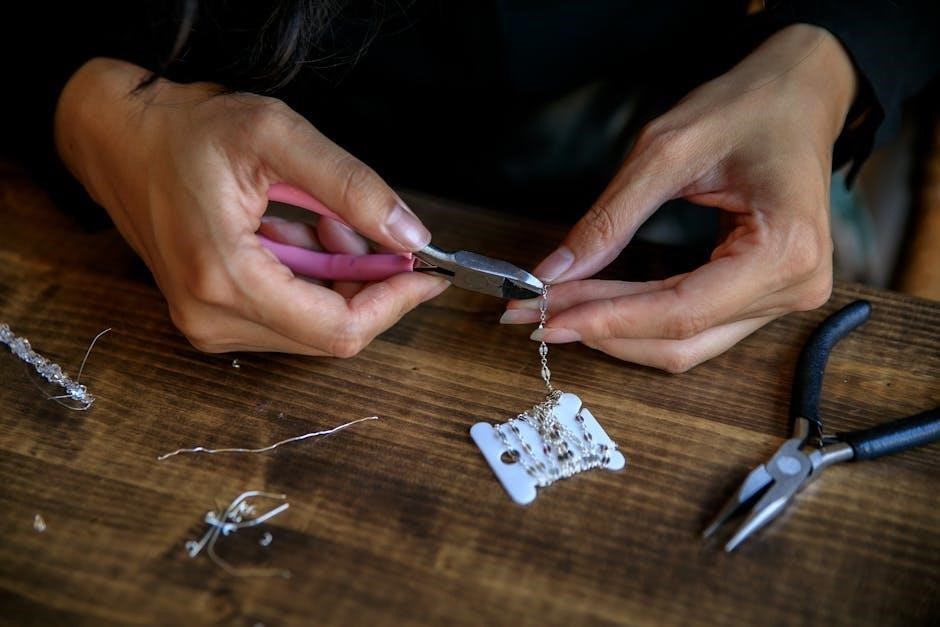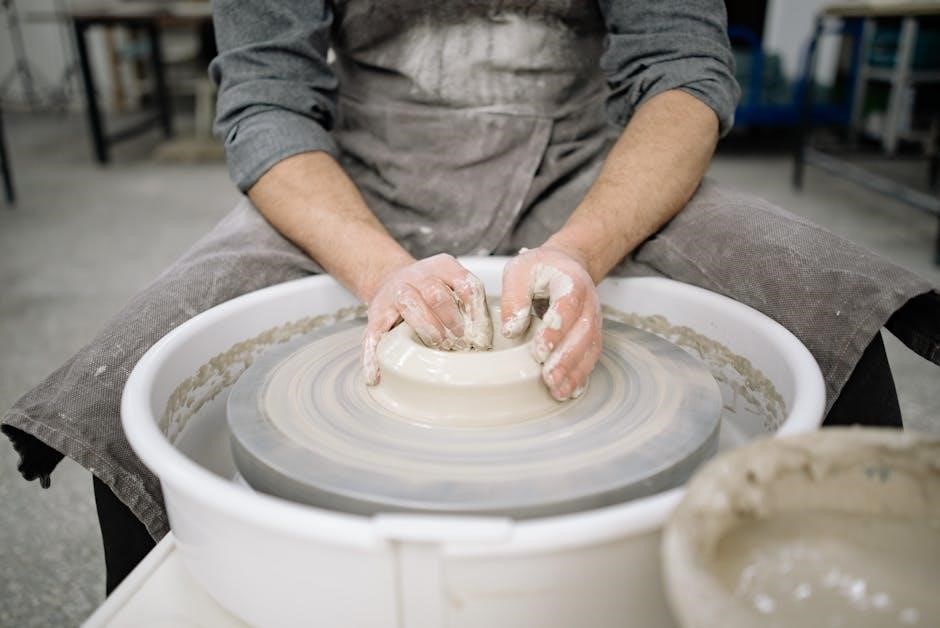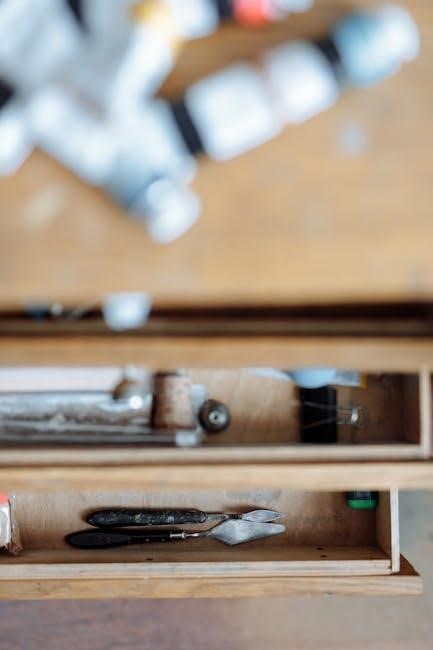Welcome to the Frigidaire Ice Maker Troubleshooting Manual! This guide provides step-by-step solutions to common issues, ensuring your ice maker operates efficiently․ From power supply checks to water line inspections, we cover essential maintenance and repair tips to resolve problems quickly․ Whether your ice maker isn’t producing ice or the dispenser is malfunctioning, this manual offers detailed guidance to restore functionality․ Regular upkeep and understanding key components like the bail arm and thermostat are crucial for optimal performance․ Let’s dive into troubleshooting your Frigidaire ice maker effectively!
1․1 Overview of Common Issues
The Frigidaire ice maker often faces issues like ice production stopping, power supply problems, or water supply disruptions․ Common complaints include faulty temperature settings, jammed bail arms, and clogged water lines․ Users may also encounter ice quality problems, such as small or discolored cubes, or dispenser malfunctions․ Identifying these issues early ensures quick resolution and prevents further damage․ Regular maintenance can help avoid many of these common problems․
1․2 Importance of Regular Maintenance
Regular maintenance is crucial for ensuring your Frigidaire ice maker operates efficiently․ Cleaning the unit, checking water lines for kinks, and ensuring proper freezer temperatures can prevent common issues․ Additionally, inspecting the bail arm and ice mold thermostat helps maintain functionality․ Neglecting maintenance can lead to ice production problems or dispenser malfunctions․ By addressing these areas regularly, you can extend the lifespan of your ice maker and avoid costly repairs․ Consistent upkeep ensures optimal performance and ice quality․

Ice Maker Not Working: Initial Checks
Check the power supply, ensure the water line isn’t kinked, and verify the bail arm’s position․ These initial steps can resolve common issues quickly․
2․1 Checking the Power Supply
Ensure your Frigidaire ice maker is properly connected to a standard 110/120 Volt, 60 Hz outlet; Verify the plug is securely inserted and the circuit hasn’t tripped․ If using a extension cord, ensure it’s rated for the appliance․ Power issues are common causes of malfunction․ Check for blown fuses or circuit breakers․ If the ice maker still doesn’t power on, consult a licensed electrician to rule out electrical system problems․
2․2 Ensuring Proper Water Supply
Check that the water supply line is connected and not kinked or frozen․ Ensure the water valve is fully open and functioning correctly․ If the “Add Water” light is on, remove the ice basket and fill the reservoir below the MAX mark․ Avoid overfilling, as this can cause issues․ If problems persist, inspect the water inlet valve for blockages or leaks․ Contact Frigidaire support if the water supply remains disrupted․
2․3 Understanding the Role of the Bail Arm
The bail arm is a metal lever that stops ice production when the ice bin is full․ It rises as ice accumulates and falls when the bin is empty․ Ensure the bail arm moves freely and is not obstructed by ice cubes or debris․ If the arm is stuck or jammed, gently adjust it to its proper position․ A malfunctioning bail arm can prevent ice production, so regular checks are essential for uninterrupted operation․

Ice Maker Not Making Ice
If your Frigidaire ice maker isn’t producing ice, check the freezer temperature, ice mold thermostat, and water supply․ Ensure the harvest cycle is functioning properly and water refills correctly after ice is ejected․ A faulty thermostat or clogged water line can halt ice production․ Regular maintenance and inspections are key to resolving these common issues efficiently․
3․1 Freezer Temperature Settings
Ensure your freezer temperature is set correctly, as a temperature above 10°F (-12°C) can prevent ice production; Check the thermostat settings and adjust if necessary to maintain optimal conditions for ice making․ For most Frigidaire models, including the EFIC117-SS and EFIC255-GREY, the ideal freezer temperature is between 0°F and 5°F (-18°C and -15°C)․ Refer to your user manual for specific temperature recommendations to ensure efficient ice production․
3․2 Ice Mold Thermostat Functionality
The ice mold thermostat monitors the temperature of the ice mold, ensuring it reaches the optimal freezing point․ Once the mold is cold enough, the thermostat activates the harvest cycle, ejecting ice cubes and refilling with water․ If the thermostat fails, the ice maker won’t produce ice․ Check for proper thermostat function and ensure it’s not defective, as this can halt the ice-making process entirely․
3․4 Harvest Cycle and Water Refill Process
The harvest cycle is crucial for ice production․ Once the ice mold reaches the proper temperature, the thermostat triggers the cycle, ejecting ice cubes into the bin and refilling the mold with water․ Issues like obstructions or a faulty water supply can disrupt this process․ Ensure the water line is connected and the mold is clear to maintain smooth operation․ Regular checks prevent cycle failures and ensure consistent ice production․

Ice Dispenser Issues
If your Frigidaire ice dispenser isn’t working, check for ice in the bin, ensure the dispenser switch and motor are working, and clear any blockages․ Check the water supply connection․
4․1 No Ice in the Bin
If the ice bin is empty, ensure the ice maker is producing ice․ Check if the dispenser is clogged or jammed․ Verify the water supply is connected and functioning․ If the ice maker is working but not dispensing, ensure the dispenser switch and motor are operational․ Clean any blockages and ensure the bin is properly aligned․ If issues persist, consult the user manual or contact Frigidaire support for assistance․
4․2 Dispenser Switch and Motor Check
Inspect the dispenser switch to ensure it’s functioning correctly․ Press the switch to confirm it activates the motor․ If the motor doesn’t run, check for blockages or jammed components․ Verify the dispenser chute is clear of ice or debris․ Ensure the dispenser door or flap is sealing properly․ If issues persist, consult the user manual for guidance or contact Frigidaire support for professional assistance to resolve the problem effectively․
4․3 Ice Jam or Blockage in Dispenser
If your Frigidaire ice maker has a blockage, start by checking the dispenser chute for ice or debris․ Remove any visible obstructions gently with a plastic tool to avoid damage․ If the issue persists, empty the ice bucket and ensure the dispenser flap is functioning properly․ After clearing the blockage, test the dispenser to confirm it’s working smoothly․ Regular cleaning and maintenance can prevent future jams and ensure optimal performance․

Ice Quality Problems
Addressing ice quality issues is crucial for optimal performance․ Common problems include small or irregular cubes, cloudy or discolored ice, and mold or odor․ Check water quality, filter condition, and freezer temperature settings to resolve these issues effectively․ Regular maintenance and proper adjustments can ensure clear, fresh, and evenly formed ice cubes consistently․
5․1 Small or Irregular Ice Cubes
Small or irregular ice cubes can result from issues like improper water flow or mold temperature fluctuations․ Check the ice maker’s mold for mineral buildup or damage․ Ensure the water supply line isn’t kinked or restricted, as this affects water distribution․ If the mold thermostat isn’t functioning correctly, it may not signal the harvest cycle properly․ Cleaning or replacing the mold and ensuring proper water pressure can resolve this issue effectively․
5․2 Cloudy or Discolored Ice
Cloudy or discolored ice is often caused by impurities in the water supply or a buildup of minerals․ Regularly cleaning the ice maker and replacing the water filter can help resolve this issue․ Check for mold or algae growth in the mold, as this can also discolor the ice․ For persistent issues, consider using filtered water or descaling the system to remove mineral deposits․ This ensures clearer, healthier ice production․
5․3 Mold or Odor in Ice
Mold or unpleasant odors in your Frigidaire ice maker often result from stagnant water or improper cleaning․ To address this, clean the mold thoroughly with a mixture of water and white vinegar․ Ensure the water supply is fresh and free from contaminants․ Regularly replacing the water filter can prevent mineral buildup and bacterial growth․ If the issue persists, check for blockages in the water line or drain and ensure proper ventilation to maintain hygiene and freshness․

Defrost Mode and Ice Maker Reset
Enter defrost mode by pressing and holding specific buttons to melt excess ice․ Resetting involves unplugging the unit and plugging it back in to restore functionality and address ice-related issues effectively․
6․1 Activating Defrost Mode
To activate defrost mode on your Frigidaire ice maker, press and hold the “Up” and “Down” buttons simultaneously for 10 seconds․ This will initiate the defrost cycle, allowing any built-up ice to melt․ Ensure the unit is properly plugged in and follow the manual’s instructions for a smooth process․ Defrosting helps maintain efficiency and prevents ice buildup issues, ensuring consistent ice production․
6․2 Resetting the Ice Maker
Resetting your Frigidaire ice maker can often resolve operational issues․ Unplug the appliance and allow it to defrost for a few hours․ This process melts excess ice and resets internal components․ After plugging it back in, the ice maker should resume normal function․ If issues persist, consult the user manual for advanced troubleshooting steps or contact Frigidaire support for further assistance․ Regular resets can prevent ice buildup and ensure optimal performance․
6․3 Post-Reset Maintenance Tips
After resetting your Frigidaire ice maker, ensure proper maintenance to prevent future issues․ Clean the ice maker mold and water reservoir to remove mineral buildup․ Check the water supply line for kinks or blockages and verify the freezer temperature is set between 0-5°F (-18 to -15°C)․ Regularly inspect and replace water filters to maintain water quality․ Proper upkeep helps extend the lifespan of your ice maker and ensures consistent performance․ Schedule routine cleaning and inspections for optimal results․

Common Error Codes and Solutions
Frigidaire ice makers display error codes like “IC” or “ICEMAKER” to indicate issues․ These codes signify problems such as sensor malfunctions or communication errors․ Refer to the user manual for specific code meanings and follow the recommended troubleshooting steps to resolve the issue effectively․
7․1 Understanding Error Code Indicators
Frigidaire ice makers use error codes to indicate specific issues․ Codes like “IC” or “ICEMAKER” often relate to sensor malfunctions or communication errors․ These codes help identify the root cause of the problem, such as faulty temperature sensors or ice mold thermostat issues․ Always refer to your user manual for a detailed explanation of each code and its corresponding solution to address the issue effectively․
7․2 Specific Error Code Meanings
Specific error codes on Frigidaire ice makers indicate precise issues․ For example, “IC” or “ICEMAKER” may signal a faulty sensor or communication error․ Other codes like “E1” could point to temperature sensor malfunctions․ Always consult your user manual for exact code meanings, as they vary by model․ Understanding these codes helps pinpoint the problem, such as a defective thermostat or frozen water line, guiding you to the right fix or professional assistance needed․
7․3 Resetting Error Codes
To reset error codes on a Frigidaire ice maker, unplug the unit from the power source for about one minute to allow it to reset․ After plugging it back in, the error codes should clear․ If the issue persists, refer to the user manual for model-specific reset instructions, which may involve pressing and holding certain buttons․ If error codes recur, it indicates a potential underlying problem that may require professional servicing or component replacement․ Always ensure safety when performing resets and consult the manual for precise guidance tailored to your model․

Advanced Troubleshooting Steps
For persistent issues, inspect the water inlet valve, mold thermostat, and ejectors․ Ensure proper water flow and temperature regulation․ Consult the manual for detailed diagnostic procedures and consider professional assistance if problems persist․ Regular maintenance and component checks are crucial for long-term functionality․ Advanced troubleshooting may require specialized tools or technical expertise to resolve complex malfunctions effectively․
8․1 Checking the Water Inlet Valve
Check the water inlet valve to ensure proper water flow․ Verify connections are secure, and inspect for kinks or blockages․ Use a wrench to manually activate the valve if needed․ A faulty valve can prevent ice production, so consider replacement if issues persist․ Regular checks help maintain efficiency, ensuring your ice maker functions smoothly․
8․2 Inspecting the Ice Maker Mold
Inspect the ice maker mold for mineral buildup or scale, which can hinder ice production․ Clean the mold with a mixture of water and vinegar to remove any residue․ Ensure the mold is aligned properly and free from obstructions․ If damaged or corroded, consider replacing the mold to restore proper ice formation․ Regular cleaning prevents irregular ice shapes and maintains efficiency․
8․3 Replacing Faulty Components
If your Frigidaire ice maker has a faulty component, such as a damaged water inlet valve or a malfunctioning ice mold, replacement is necessary․ Start by unplugging the unit for safety․ Identify the faulty part using diagnostic steps from the manual․ Replace it with a genuine Frigidaire component to ensure compatibility․ After installation, run a test cycle to confirm proper function․ Regularly inspect and replace worn-out parts to maintain efficiency and prevent future issues․
Preventive Maintenance Tips
Regularly clean the ice maker to prevent mold and mineral buildup․ Inspect and replace water filters every 6 months․ Ensure the water supply line is connected and not kinked․
9․1 Cleaning the Ice Maker
Turn off and unplug the ice maker before cleaning․ Remove the ice bin and wash it with mild soap and warm water․ Use a mixture of equal parts water and white vinegar to wipe down the interior, removing mineral buildup and mold․ Rinse thoroughly and dry with a clean cloth․ Regular cleaning every 3-6 months ensures optimal performance and prevents bacteria growth․ Always follow the manual’s cleaning instructions for best results․
9․2 Inspecting and Replacing Water Filters
Regularly inspect and replace the water filter to ensure clean water flow and prevent mineral buildup․ Locate the filter, typically near the water inlet valve․ Turn off the water supply and remove the old filter․ Install a new Frigidaire-approved filter by aligning it properly and securing it․ Replace the filter every 6 months or as indicated in your manual․ This maintains water quality and prevents issues like slow ice production or poor taste․
9․3 Scheduling Regular Maintenance
Regular maintenance is crucial for optimal ice maker performance․ Schedule monthly cleaning of the ice maker and its components to remove dirt and mineral buildup․ Check and replace worn-out parts annually․ Ensure the water supply line is free from kinks and leaks․ Refer to your manual for recommended maintenance timelines and procedures․ Consistent upkeep will prevent unexpected breakdowns and ensure your Frigidaire ice maker runs efficiently year-round․

Model-Specific Troubleshooting
Frigidaire ice maker models like EFIC117-SS and EFIC255-GREY may have unique issues․ This section provides tailored solutions for specific models, ensuring effective troubleshooting based on your unit’s design․
10․1 Frigidaire EFIC117-SS Issues
The Frigidaire EFIC117-SS often experiences issues like the “Add Water” light staying on, indicating low water levels․ Ensure the reservoir is filled below the MAX mark․ Additionally, check the power supply and bail arm functionality․ If the ice maker stops producing ice, verify the water supply line for kinks or blockages․ Resetting the unit by unplugging it for 30 minutes can often resolve software-related glitches․ Regular cleaning and maintenance are key to preventing these issues․
10․2 Frigidaire EFIC255-GREY Problems
Common issues with the Frigidaire EFIC255-GREY include ice jams and inconsistent ice production․ Check for blockages in the ice chute and ensure the water filter is clean․ If the unit doesn’t turn on, verify the power connection and ensure the child lock is disabled․ Running a cleaning cycle or resetting the ice maker can often resolve operational issues․ Refer to the user manual for specific model instructions to maintain optimal performance and address specific faults effectively․
10․3 Other Common Models
Beyond the EFIC117-SS and EFIC255-GREY, other Frigidaire models like the Efic115-BLACK and Efic206 often face similar issues․ Ensure water lines are unobstructed and filters are clean․ For models with digital displays, check for error codes and reset if necessary․ Regular defrosting and cleaning can prevent common problems like slow ice production or faulty sensors․ Always consult the specific model’s manual for tailored troubleshooting steps to maintain efficiency and extend the unit’s lifespan effectively․

When to Call a Professional
If basic troubleshooting steps fail to resolve the issue, it’s time to contact a certified technician․ Complex problems like faulty sensors or electrical issues require professional expertise to fix safely and effectively․
11․1 Identifying Severe Issues
Severe issues with your Frigidaire ice maker may include a faulty water inlet valve, a malfunctioning mold thermostat, or a failed harvest cycle․ If you notice persistent problems like error codes, unusual noises, or physical damage to components, it’s essential to seek professional help․ These issues often require specialized tools and expertise to repair safely and effectively, ensuring your ice maker functions properly without further complications․
11․2 Contacting Frigidaire Support
If you encounter issues beyond your troubleshooting abilities, contact Frigidaire Support directly․ Visit their official website and navigate to the support center for assistance․ You can also call their customer service hotline, available in the user manual․ Provide your ice maker’s model number and a detailed description of the problem․ Their team can offer guidance, repair options, or direct you to authorized service providers to resolve the issue promptly․
11․3 Hiring a Certified Technician
If issues persist after troubleshooting, consider hiring a certified technician․ They specialize in diagnosing complex problems like faulty thermostats or ice maker molds․ Ensure the technician is authorized by Frigidaire to maintain warranty validity․ A professional can replace defective parts and ensure proper functionality, saving time and preventing further damage․ Always verify credentials and reviews before scheduling a service to guarantee reliable and efficient repairs․
References and Additional Resources
Refer to the user manual for model-specific guidance․ Visit online support forums and Frigidaire’s official website for troubleshooting guides, manuals, and contact information to resolve ice maker issues effectively․
12․1 User Manual Guidelines
The Frigidaire ice maker user manual provides detailed instructions for troubleshooting and maintaining your appliance․ It includes model-specific guidelines, diagnostic steps, and safety precautions․ Refer to the manual for information on resetting the ice maker, checking error codes, and performing routine maintenance․ The manual also outlines warranty details and contact information for Frigidaire support․ Always follow the manufacturer’s recommendations to ensure optimal performance and extend the lifespan of your ice maker․
12․2 Online Support and Forums
Frigidaire offers extensive online support through their official website, including troubleshooting guides, FAQs, and model-specific repair manuals․ Online forums and communities, such as appliance repair groups, provide user-generated solutions and tips for common ice maker issues․ You can also access detailed repair videos and expert advice․ These resources help diagnose problems like faulty water lines or power supply issues, ensuring quick resolutions without professional assistance․ Utilize these tools for reliable and efficient troubleshooting․
12․3 Manufacturer Contact Information
For direct assistance, contact Frigidaire’s customer support at their official website or call their dedicated helpline․ The manufacturer provides detailed contact information, including phone numbers and email options, to address specific concerns․ Visit their support page for model-specific guidance, troubleshooting resources, or to schedule professional repairs․ Frigidaire’s team is available to help resolve issues efficiently, ensuring your ice maker operates smoothly․ Reach out for personalized assistance anytime․
By following this Frigidaire Ice Maker Troubleshooting Manual, you’ve gained insights to identify and resolve common issues․ Regular maintenance and prompt repairs ensure optimal performance․ Keep your ice maker functioning smoothly with these expert tips and guidelines for a consistent ice supply․ Happy troubleshooting!
13․1 Summary of Key Points
This manual has guided you through identifying and resolving common Frigidaire ice maker issues, such as power supply problems, water line blockages, and faulty components․ Regular maintenance, like cleaning and checking the bail arm, ensures smooth operation․ Understanding freezer temperature settings and troubleshooting error codes can prevent future issues․ Always refer to your user manual for model-specific guidance and maintain optimal performance for consistent ice production․
13․2 Final Tips for Optimal Performance
To ensure your Frigidaire ice maker runs smoothly, always defrost regularly and check for ice buildup․ Inspect water lines for kinks or blockages and replace filters as needed․ Keep the surrounding area clean and well-ventilated to maintain efficiency․ Refer to your user manual for model-specific care instructions and follow routine maintenance schedules to prevent issues․ By adhering to these tips, you’ll enjoy consistent ice production and extend your appliance’s lifespan․